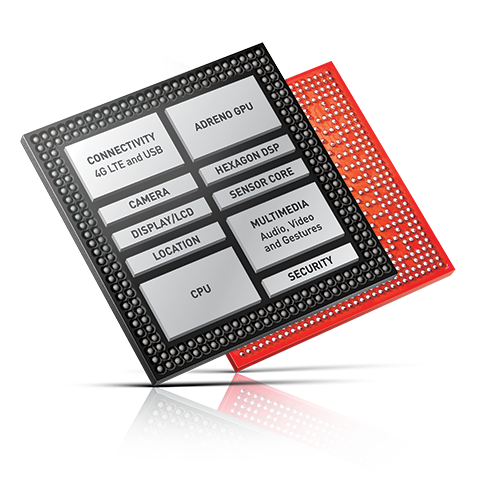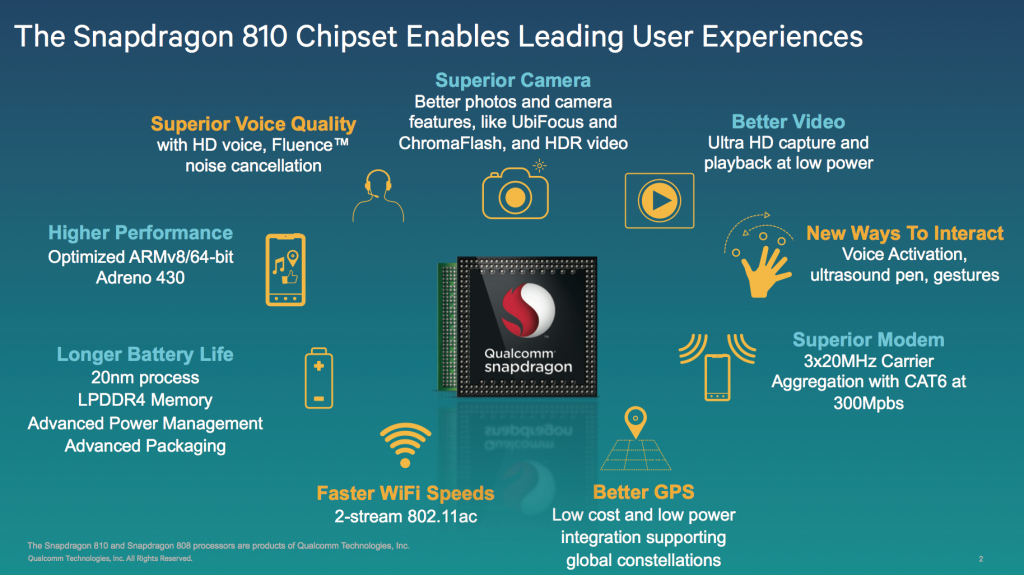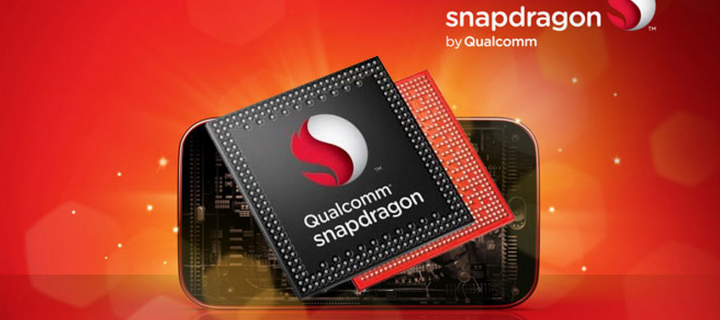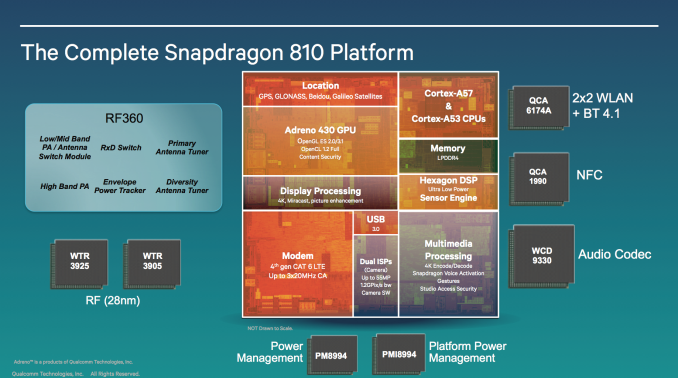
Amidst of all the exciting gadgets announced at the CES this year, what caught our eye is the new Qualcomm Snapdragon 810 processor featuring in the LG’s latest ‘G Flex 2’. Qualcomm touts about the same by claiming it to be the ultimate connected computing processor. The Snapdragon comes as an advancement to the company’s 8XX processor series. This processor is designed for providing the best of computing and multitasking experience to the users.
Improvements in the core layout have been imparted in the Snapdragon 810. The core is Quad-core ARM Cortex A57 and Quad-core A53 with 64-bit support instead of four Krait cores which were present in the Snapdragon 801. A new GPU – Qualcomm Adreno 430 has been pushed in with the processor. The Adreno 430 GPU gives out better performance and uses less power than its previous counterparts. The core has been manufactured by the new process based on 20nm HPM (High Performance Mobile) just like the Snapdragon 805. This makes the processor more power efficient than the previous Snapdragon 801.
More features for the Snapdragon 810 read out as support to 64-bit LPDDR4 memory unit running at 1600MHz (DDR4 RAM support), USB3.0/2.0 and supports the eMMC 5.0 like the other processors in the family. The processor has integrated 4G LTE CAT-6 modem which makes it enable to support speeds up to 300Mbps using carrier aggregation. This is a considerable improvement over the the previous Snapdragon 801 (with CAT-4) enabling speeds up to 150Mbps. The processor also supports Bluetooth v
4.1 and 4K video stream and upload.
The processor is boosted up with the Qualcomm Quick Charge technology with parallel charging, HEVC (High Efficiency Video Coding) encoding and decoding making the user to exchange more data bits with less usage of bandwidth, a dual signal processor for supporting higher quality photos and 11.1 surround sound support.
Looking pensively at the features and all the new powers being enabled for the users, there are some skeptic points coming to our minds. These revolve around the fact that can the improvements actually deliver on what they claim to? And are these features really that useful to the daily Jack?

But, the biggest highlight of the processor isn’t its core supporting 64-bit operations but its revision of the architecture to ARMv8 from the previous ARMv7. This improved instruction set efficiency makes the CPU fetch data from the RAM in a more speedy manner, which in turn means that the CPU now can cater to larger RAM units like 4GB or more. But in reality, there is a void of applications that actually use/need such high amount of memory spaces. So in turn this improvement of shifting towards the ARMv8 architecture might not help the users in their smartphone experience as it was intended to.
Looking specifically at the point where the Snapdragon 810 has been built to support eMMC 5.0 type of internal storage, it looks pretty impressive to have such fast flash drives integrated in our smartphones. The speed of the internal storage comes with increased cost of the same. So in reality, manufacturers refrain from using such fast flash drives to keep the overall costs within the required range. Also on the other hand, having such speedy storages isn’t exactly the bling a regular user looks for.
That being cleared, the point of enabling the processor to support USB 3.0 standards might lose its ground. After all, without fixing your smartphones with faster storage mechanism, this new faster USB 3.0 standard cannot be used for data transfer. Also talking about the super fast LTE capabilities bestowed by the integrated CAT-6 modem, it looks pretty impressive to be able to use the speed of 300Mbps (where your network allows to). But similarly, without integration of faster memory devices, one might find no use of such fast network connections. The HEVC encoding based 4K video support too looks of no use.
In this technological era with the display quality of the screens constantly improving, the 4K resolution supporting screens have a considerably large amount of pixels to be handled when compared to the previous full-HD screens. On the other hand, the development in the GPUs haven’t been up to the same margins. Coming back to the improved GPU – Qualcomm Adreno 430 has been claimed to give out better performance, enabling the devices to sport 4K resolution videos and a redefined 3D gaming experience. There are doubts that even after all the improvements in the GPU, will it render enough support to the 4K resolution displays to make them run hassle free?
Looking at all the claims by Qualcomm about the ‘revolutionary’ improvements in Snapdragon 810, there still are some speculations about the Snapdragon 810 not making enough improvements as expected over the Snapdragon 801 which powered the OnePlus One and the Moto X 2nd Gen. As of now the processor has been set in one of the customary device (the LG G Flex 2), more facts and figures will make their way out. But we must say that Qualcomm has left no stone unturned for improving the Qualcomm Snapdragon 810 and have put out the best we’ve seen so far.






